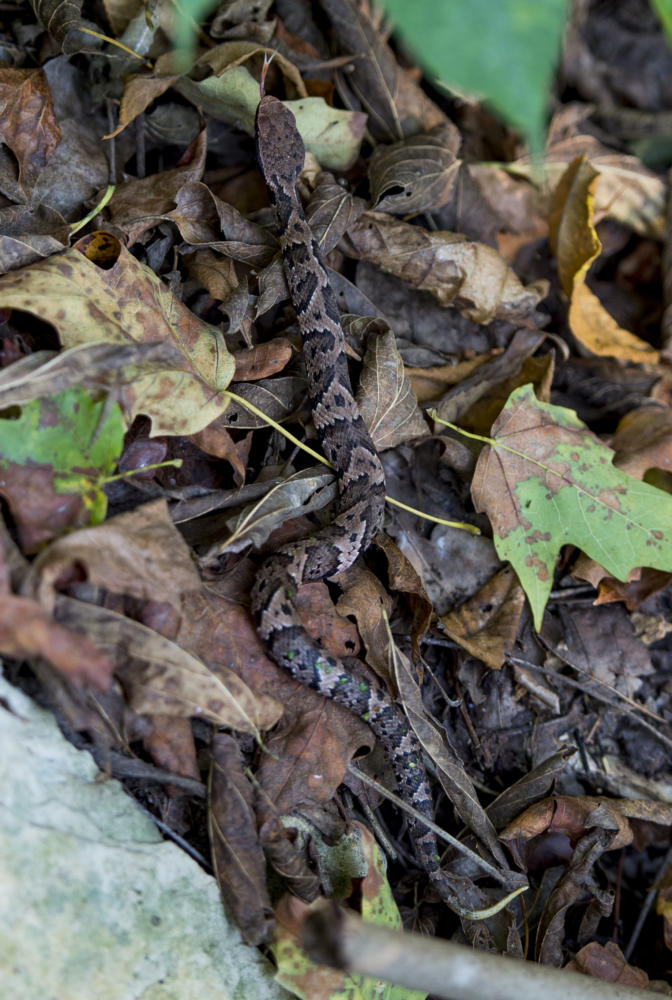Sightseers slither into southern Illinois for Snake Road
A cottonmouth snake basks in the sun Sunday, September 24, 2017 at snake road (Dylan Nelson | @Dylan_Nelson99)
September 27, 2017
Southern Illinois’ Snake Road, which serves as a migration path for snakes and amphibians going from their summer to winter homes, draws people from all over the country who want to see rare and endangered species.
Some, like zoology graduate student Connor French, come to SIU just to be near the 2.5 mile stretch of road that runs along the Mississippi near Jonesboro.
“Snake Road is kind of representative of breaking my stereotyped ideas of Illinois,” said French, who is originally from Dallas. “I figured Illinois would be super flat and boring, but when I heard that there is this cool place where tons of [herptiles] are and swamps and cliffs, I was like ‘Holy shit! This is pretty sweet.’”
Advertisement
Snake Road, also known as Road 345, runs parallel to La Rue Pine-Hills in the Shawnee National Forest, according to the forest’s website. It is closed to vehicles — but still open to visitors on foot — from Sept. 1 to Oct. 30 in the stretch between milepost 3.0 and 5.8 for the herptile migration.
Scott Ballard, a herpetologist for the Illinois Department of Natural Resources, said Snake Road was first closed to vehicular traffic in 1972.
Ballard said the dates the Forest Service closed the road used to be random and only about three weeks long. He finished his master’s thesis at SIU in 1987, which recommended the Forest Service close the road for two months each spring and fall instead of the three random weeks.
The Forest Service accepted his proposal, and Snake Road is now the only place in the country where a road is closed off to protect migrating herptiles, Ballard said.
Though the actual number of reptiles and amphibians saved by closing Snake Road is unknown, forest officials say it is clear that there are fewer amphibian and reptile deaths there than in other migratory paths that vehicles can pass through.
The road is home to over 56 species of reptiles and amphibians during the migration period. Ballard said the road’s closure allows some endangered or threatened reptiles and amphibians migrate safely to their seasonal habitats.
Ballard said the road houses three endangered species of snakes and one endangered species of frog.
Advertisement*
The most common snakes are cottonmouths — also known as water moccasins — water snakes and rat snakes, French said.
According to National Geographic, there are three types of venomous snakes on the road: cottonmouths, copperheads and timber rattlesnakes.
“If you were allowed to drive across [the road] during migration, there would just be mass mortality, and there are some not-so-common species that [pass] by there,” French said. “It’s important to maintain diversity.”
French, who is president of SIU’s Herpetology Club, said the group takes trips out to Snake Road to see the bi-annual migration.
“I love the diversity and accessibility,” French said. “In such a small area, there are quite a few species of [herptiles] and you’re seeing things that normally wouldn’t be in that place.”

A baby cottonmouth snake slithers through the forest floor Sunday, September 24, 2017, at snake road. (Dylan Nelson | @Dylan_Nelson99)
Ballard said the road doesn’t just draw well-meaning tourists. Though most visitors are respectful and abide by regulations, he said there is a small percent of people that visit the road for personal gain or are not mindful of the habitat they’re visiting.
With the increased traffic during migration, French added it is important to put back everything that is displaced — such as flipped rocks and logs — so the environment look untouched.
Displaced rocks and logs can lead to salamanders perishing because their habitat dries out, he said.
“It’s a high traffic area,” French said. “You don’t want to destroy the habitat surrounding it. You have got to be a good steward.”
According to Forest Service regulations, visitors cannot collect anything from the road and must be respectful toward the species that live there.
Visitors found with tools to collect shedded reptile skin will be detained, Ballard said. Aggravating, herding or gathering any species also violates Forest Service regulations.
French and Ballard said it is important to protect the road because it’s one of the most interesting places in southern Illinois.
“[Snake Road] is my favorite place to be,” Ballard said. “My worst day there … is still better than the best day at the office. It is just a chance to get out, walk and be with nature. You lose all your worries when you’re walking the road.”
Staff writer Isabelle Rogers can be reached at irogers@dailyegyptian.com or on Twitter @isabellearogers.
To stay up to date with all your Carbondale news, follow the Daily Egyptian on Facebook and Twitter.
Advertisement








